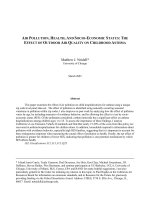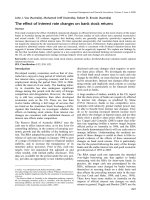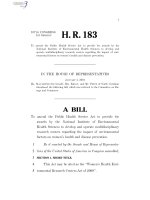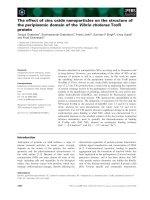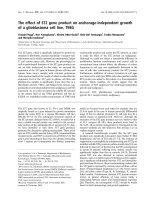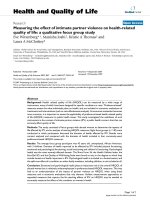The effect of transpormational leadership factors on organizational commitment, job satisfaction and trust in Vietnamese state-owned organizations
Bạn đang xem bản rút gọn của tài liệu. Xem và tải ngay bản đầy đủ của tài liệu tại đây (1.34 MB, 88 trang )
UNIVERSITY OF ECONOMICS HO CHI MINH CITY
International School of Business
------------------------------
Pham Trong Kha
THE EFFECT OF TRANSFORMATIONAL
LEADERSHIP FACTORS ON
ORGANIZATIONAL COMMITMENT, JOB
SATISFACTION AND TRUST IN VIETNAMESE
STATE-OWNED ORGANIZATIONS
MASTER OF BUSINESS (Honours)
Ho Chi Minh City – Year 2014
UNIVERSITY OF ECONOMICS HO CHI MINH CITY
International School of Business
------------------------------
Pham Trong Kha
THE EFFECT OF TRANSFORMATIONAL
LEADERSHIP FACTORS ON
ORGANIZATIONAL COMMITMENT, JOB
SATISFACTION AND TRUST IN VIETNAMESE
STATE-OWNED ORGANIZATIONS
ID: 22120051
MASTER OF BUSINESS (Honours)
SUPERVISOR: Dr. Pham Quoc Hung
Ho Chi Minh City - Year 2014
TABLE OF CONTENTS
ACKNOWLEDGEMENT
ABSTRACT
CHAPTER 1: INTRODUCTION .......................................................................................... 1
1.1 Research background ............................................................................................. 1
1.2 Research objectives ................................................................................................ 3
1.3 Significance of research ......................................................................................... 3
1.4 Research methodology and research scope ............................................................ 4
1.5 Research structure .................................................................................................. 5
CHAPTER 2: LITERATURE REVIEW ............................................................................... 6
2.1 Transformational leadership ................................................................................... 6
2.2 Relationship between transformational leadership factors and job satisfaction …8
2.3 Relationship between transformational leadership factors and trust ...................... 11
2.4 Relationship between transformational leadership and organizational
commitment…………………………………………………………………………………12
2.5 Relationship between idealized influence, empowerment and organizational
Commitment. ......................................................................................................................... 14
2.6 The conceptual model and hypotheses of the research .......................................... 17
CHAPTER 3: RESEARCH METHODOLOGY ...................................................................19
3.1 Sample .................................................................................................................... 20
3.2 Data collection and procedure ................................................................................ 21
3.3 Questionnaire design .............................................................................................. 22
3.4 Data analysis method .............................................................................................. 25
CHAPTER 4: DATA ANALYSIS AND RESULTS ............................................................ 27
4.1 Respondents’ demographics ................................................................................... 27
4.2 Reliability Analysis ................................................................................................ 28
4.3 Exploratory Factor Analysis (EFA)........................................................................ 30
4.4 Regression Analysis ............................................................................................... 34
4.4.1 Multiple Regression Analysis to define the effect of idealized influence,
inspirational motivation, intellectual stimulation, individualized consideration on job
satisfaction. ..................……………………………………………………………34
4.4.2 Multiple Regression Analysis to define the effect of inspirational motivation,
intellectual stimulation, individualized consideration on Trust ............................... 40
4.4.3 Multiple Regression Analysis to define the effect of inspirational motivation,
intellectual stimulation, individualized consideration on Commitment…………...43
4.4.4 Simple Regression Analysis to define the effect of idealized influence on
empowerment..………….........................................................................................46
4.4.5. Simple Regression Analysis to define the effect of empowerment on
commitment………………………………………………………………………..47
CHAPTER 5: CONCLUSION, IMPLICATIONS AND LIMITATIONS ............................ 51
5.1 Conclusion and discussion ..................................................................................... 51
5.2 Implications ............................................................................................................ 52
5.3 Limitations and future research direction ............................................................... 53
REFERENCES ...................................................................................................................... 55
APPENDICES ....................................................................................................................... 65
Appendix A: Guidelines for In-depth Interview
Appendix B: Questionnaire (English Version)
Appendix C: Questionnaire (Vietnamese Version)
Appendix D: Histogram, Normal Regression & Scatter plot of Dependent
LIST OF FIGURES
Figure 2.1: A theoretical model
Figure 3.1: Research Process
Figure D-JS1: Histogram of Job Satisfaction
Figure D-JS2: Normal Plot of Job Satisfaction
Figure D-JS3: Scatter Plot of Job Satisfaction
Figure D-TR1: Histogram of Trust
Figure D-TR2: Normal Plot of Trust
Figure D-TR3: Scatter Plot of Trust
Figure D-CO1: Histogram of Organizational Commitment
Figure D-CO2: Normal Plot of Organizational Commitment
Figure D-CO3: Scatter Plot of Organizational Commitment
Figure D-EM1: Histogram of Empowerment
Figure D-EM2: Normal Plot of Empowerment
Figure D-EM2: Scatter Plot of Empowerment
LIST OF TABLES
Table 3.1 Source of measurement scale
Table 4.1: Sample Demographics.
Table 4.2 Reliability test result
Table 4.3 KMO and Bartlett's Test
Table 4.4 Rotated Component Matrix
Table 4.5 Total Variance Explained
Table 4.6 Correlations matrix of Job Satisfaction, Idealized influence, Inspirational motivation,
Intellectual stimulation and Individual consideration
Table 4.7 Model Summary of multiple regression analysis
Table 4.8 ANOVA of multiple regression analysis
Table 4.9 Coefficients of multiple regression analysis
Table 4.10 Correlations matrix of Trust, Inspirational motivation, Intellectual stimulation and
Individual consideration
Table 4.11 Model Summary of multiple regression analysis
Table 4.12 ANOVA of multiple regression analysis
Table 4.13 Coefficients of multiple regression analysis
Table 4.14 Correlations matrix of Commitment, Inspirational motivation, Intellectual
stimulation and Individual consideration
Table 4.15 Model Summary of multiple regression analysis
Table 4.16 ANOVA of multiple regression analysis
Table 4.17 Coefficients of multiple regression analysis
Table 4.18 Model Summary of simple regression analysis
Table 4.19 ANOVA of simple regression analysis
Table 4.20 Coefficients of simple regression analysis
Table 4.21 Model Summary of simple regression analysis
Table 4.22 ANOVA of simple regression analysis
Table 4.23 Coefficients of simple regression analysis
Table 4.24 Summary of hypotheses testing result
ABSTRACT
According to many previous studies, the effective leaders are one of the most
important factors creating influences on the performance in the Vietnamese stateowned organizations;. The purpose of this study was to investigate the relationship
between transformational leadership factors and job satsifactions, trust and
organizational commitment in Vietnamese state-owned organizations. There are 208
qualified respondents including 123 men (occupied 59 percent) and 85 women
(occupied 41 percent), aged from 22 to over 40 years old. All of respondents have
over 2-year working experiences and there are about 23% of respondents who are
keeping at least Deputy Manager positions.
The findings of the study indicated that transformational leadership
factors
including
indealized
influence,
inspirational
motivation,
intellectual
stimulation and individualized consideration have significant and positive correlations
with job satisfaction, trust and organizational commitment.
The research results have contributed to the literature and provided more
evidences for the managers in their decisions of their workforce. However, the
sample for the research is still limited due to the application of convenient sampling
method and surveyed only in Ho Chi Minh City and Vung Tau city.
Keywords: transformational leadership, indealized influence, inspirational motivation,
intellectual stimulation and Individualized consideration,
organizational commitment
job satisfaction, trust and
-1-
CHAPTER 1: INTRODUCTION
1.1 Research background
The effective leadership is considered one of the most concerning challenges
in the organizations and becomes a common topic for many discussions in recent
years. Effective leaders could be understood as the ones who have the ability to
create influence and know how to involve others, enabling them to act within the
correct vision, mission and goals so that the organization heads in the right direction
and uses the correct methods to get there (Einstein & Humphreys, 2001).
In the private sector, the leadership style has been changed and updated to be
more effective in operations but the Vietnamese state-owned organizations are still
led in the old leadership style, which could be a big concern for Vietnam’s
development in the future. According to Gates (2000), in the Vietnamese stateowned organizations, the environment is evaluated to be lacked most of the
elements essential to a market-oriented economy. In general, it’s evaluated as an
environment still lacks of the activeness and changes to improve the organization
performance in the fast development of the Vietnam market during two recent
decades.
The full range of leadership theory developed by Avolio and Bass (1994)
forms a continuum, which describes the laissez-faire style of leadership at one end,
then toward the middle of the continuum appears the transactional style of
leadership, and finally moving to the opposite side of the continuum, the
transformational style of leadership resides. The laissez-fare style of leadership
-2-
describes a hands-off approach to leadership. Transactional leadership deals with an
exchange or transaction between the leader and follower, usually the leader outlines
responsibilities and attaches rewards to the follower's compliance and fulfillment of
obligations. In the meantime, the transformational style is different from
transactional style because the leader engages the follower by looking for creative
solutions to problems and treats each follower as an individual who deserves
mentoring and coaching (Bass, 1997).
In respect of considering which style is best suited to motivate followers to
achieve a higher level of performance, increase their job satisfaction and increase
their commitment to the organization? Homrig (2002) stated that transformational
model of leadership is best suited for today's and tomorrow's strategic
environment". Waldman et al. (1990) stated that when a transformational leader
finds him or herself in a non win-win situation, he or she will try to convert this
situation to a win-win problem-solving situation. Thus, transformational leadership
is one of critical solutions for the effective organizations.
There are many previous researches which have studied the positive
relationship between transformational leadership behaviors and job satisfaction,
trust and organizational commitment in the workplace. However, the number of
studies conducted in Vietnam and specifically in Vietnamese state-owned
organizations about this topic is very limited. Therefore, this research will focus on
investigating the link between transformational leadership factors and some
workplace determinants including job satisfaction, trust and organizational
commitment in the Vietnamese state-owned organizations.
-3-
In summary, the final goal of this research is to examine the relationships
among transformational leadership, organizational commitment, job satisfaction and
trust, which could eventually help managers, leaders and workers in the Vietnamese
state-owned organizations understand this relationship and convert this into higher
performance for the organization.
1.2 Research objectives
The purpose of this study was to examine the relationship between
transformational leadership factors, job satisfaction, organizational commitment and
trust in the Vietnamese state-owned organizations. Particularly, the research will
investigate:
-
The relationship between factors of transformational leadership on job
satisfaction
-
The relationship between factors of transformational leadership on trust
-
The relationship between factors of transformational leadership on
organizational commitment
-
The mediating role of the empowerment to the relationship between the
idealized influence and the organizational commitment.
1.3 Significance of the research
This study contributes to leadership theory and practice in its examination of
influences of transformational leadership factors on the employee’s attitudes job
satisfaction, organizational commitment and the trust in the Vietnamese state-owned
-4-
organizations. The research also enhances the amount of information available to
leaders and allows leaders to respond to their followers' needs.
1.4 Research methodology and research scope:
This study uses questionnaire to collect data. The survey questionnaire is
originally developed in English and then translated into Vietnamese. In-depth
interviews are then conducted with 10 people in order to modify the Vietnamese
version of the questionnaire before the survey is implemented in mass. The next step
is analyzing the collected data. The data of this research is processed using SPSS
software with three main stages. First, Cronbach’s Alpha is used to test the reliability
of the measurement scale. Then, the validity of the measurement scale will be checked
by Exploratory Factor Analysis (EFA). Finally, simple regression and multiple
regression are employed as the main method for investigating the relationships among
factors in the research model.
Respondents, who have been chosen to conduct the survey for this study, are
working for the state-owned organizations in Ho Chi Minh City and Vung Tau City.
1.5 Research structure
This study is organized into five chapters. It starts with the introduction chapter
which presents an outline of this research. This chapter includes background of the
research, motivation for doing research, and research objectives. Besides, this chapter
also has a brief definition of key terms as well as scope of the research and
methodology of data analysis is also mentioned. Chapter two reviews and synthesizes
-5-
the theories in the literature of 8 concepts, including 4 factors of transformational
leadership (idealized influence, inspirational motivation, individualized consideration,
and intellectual stimulation), empowerment, commitment, trust and job satisfaction.
This chapter also describes research model and proposed hypotheses. Chapter three
introduces research methodology used to empirically test the research model. Chapter
four presents the results of data analysis. The final chapter discusses summarily the
study’s core findings, suggests some recommendations for business strategy of
international luxury companies based on findings and finally points out some
limitations of the research.
-6-
CHAPTER 2: LITERATURE REVIEW
This chapter mainly introduces the theories, which are proposed by many
scholars in academic field, relate to each of factors in the model, research model of the
study, and propose the hypotheses for the research.
2.1 Transformational Leadership
The Multifactor Leadership Questionnaire (MLQ) developed by Avolio and
Bass (1995) provides an instrument to measure degrees of the existence oflaissezfaire, transactional and transformational styles of leadership
as perceived
by
followers. Transformational leadership has four important features: Idealized
influence, Inspirational Motivation, individualized consideration and intellectual
stimulation (Avolio et al., 1999; Bass & Avolio, 1993, 1994; Ismail et al., 2010; Pillai
et al., 1999)
The concept of transformation was first time introduced by Burns (1978)
focusing on morals and ethics (Bass, 1985a, 1985b; Burns, 1978). In the mid1980, the paradigm of leadership shifted from transactional and charismatic
leadership to transformational leadership, since Bass refined theory of Burns
(1978). In contrast to transactional leadership, “Transformational leadership
encourages human development and interaction and promotes collective motivation
and outcomes” (Jung & Sosik, 2002, p. 316).
Transformational leadership is the ability to influence and motivate others so
that followers want to achieve organizational success. Transformational leaders
-7-
express a general interest in their followers and there is a mutual trust between
the leader and followers. Since the inception of the theoretical constructs that
comprise transformational leadership, research has demonstrated the relationship
of transformational leadership to job satisfaction, effectiveness and organizational
commitment (Bass, 2000).
Idealized influence
Charisma or idealized influence describes leaders who act as strong rolemodels for followers, and whom followers seek to emulate. These leaders have very
high standards of conduct, moral principles and ethical values (Aronson, 2001).
They also provide their followers with a clear vision and a mission for their
organizations and, in turn, earn a high degree of respect and trust by their followers
(Bass & Avolio, 1994; Bass, 1999; Bass & Steidlmeier, 1999; Nahavandi, 2006).
Inspirational Motivation
For the purpose of this study, inspirational motivation refers to the leader's
ability to motivate and inspire followers by supplying and offering challenges and
meaningful work. The leader creates an atmosphere of team cohesiveness and
models a sense of optimism. Bass and Avolio (1994) observed that transformational
leaders inspire followers by clearly communicating expectations, motivating
followers to want to meet these expectations, and by demonstrating commitment to
the organizational goals and sharing a clear vision of the organization's future
potential.
Individualized Consideration
-8-
For the purpose of this study, individualized consideration refers to the
leader's ability to act as a mentor to organizational members by paying attention to
each individual's needs, achievement, motivations and growth. Such leaders enable
their followers to develop their potential to higher levels than the followers
anticipated by delegating tasks, monitoring progress, checking to see if additional
support is needed and listening effectively. Bass and Avolio (1994) stated that a
two-way exchange in communication is encouraged and management by walking
around work spaces is practiced.
Intellectual Stimulation
For the purpose of this study, intellectual stimulation refers to the leader's
ability to motivate and stimulate followers to be creative and innovative, and to
constantly challenge the current state of the organization. Transformational leaders
do not publicly criticize their followers and encourage them to have a different view
from the leader. Bass & Avolio (1994) stated that new ideas and creative problem
solutions
are solicited from followers,
addressing
problems
who are included in the process of
and finding solutions.
Followers are encouraged to
contribute to solving problems, not creating problems.
2.2. Relationship between transformational leadership factors and job
satisfaction
For the purpose of this study, job satisfaction is the attitude that individuals
have about their job within their work environment. The attitude is based on the
perceptions of their surrounding work environment, which includes the leadership,
-9-
opportunities for growth, policies and procedures, working conditions, co-worker and
supervisor relationships and fringe benefits (Gibson et aI., 2003).
Job satisfaction as defined by Herzberg'S two-factor theory (1966) states that
there are content (internal) and context (external) factors that measure an
employee's degree of job satisfaction. The content factors include the intrinsic
feelings of accomplishment and achievement, meaningful work, recognition and
increased responsibility. The absence of these factors may not prove to be
dissatisfying, but the presence of them may build strong levels of motivation and
job performance. The context factors include those factors such as pay, status,
fringe benefits, policies, procedures and interpersonal relations. The presence of
these factors may not necessarily motivate the individual, but the absence of them
will result in dissatisfaction (Gibson, Ivancevich, Donnelly, & Konopaske, 2003).
Chen (2005) describes job satisfaction as an emotional state resulting from
the evaluation of one's job that can be negative, neutral or positive. Roznowski and
Hulin (1993) suggests that an employee who maintains a negative or low level of
job satisfaction engages in four types of behavior. The employee may choose to use
work time to pursue personal tasks or steal. The employee may exhibit behaviors
that show a withdrawal from the job psychologically such as disengaging or not
attending functions or meetings. The employee may choose to be absent frequently,
leave the job or opt for early retirement. Finally, the fourth suggested behavior
associated with a negative level of job satisfaction deals with the employee making
attempts to change the current situation, look for a different type of job, or accept a
- 10 -
demotion or transfer. All of these behaviors translate into higher costs for the
organization and lower productivity by the unsatisfied member.
Another study conducted by Chen (2005) examined the relationship between
transformational leadership, transactional leadership, organizational commitment
and job satisfaction. The study's participants were selected from the IT department
of the Department of Research and Development from an Industrial Park in
Shanghai, China. The sample consisted of 150 full-time employees. The results of
the study revealed that a positive relationship between factors of transformational
leadership and job satisfaction. This study suggests that the factors of
transformational leadership creates an environment that increases job satisfaction
within the organization.
Furthermore, in a study of 687 participants selected from 21 secondary
schools from Taiwan, Lee (2005) studied the relationship among the teacher's
perceptions regarding their principal's degree of transformational leadership, their
organizational commitment and their job satisfaction. The study revealed that there
was a positive relationship between job satisfaction and all factors of
transformational leadership. The strongest correlations with job satisfaction were
teachers who perceived their principals possessing the transformational leadership
qualities of fostering the acceptance of group goals, providing individualized
support and articulating a vision. Thus, the researcher would like to propose a
hypothesis below:
H1. “There is a positive relationship between four factors of
transformational leadership (idealized Influence, inspirational motivation,
- 11 -
intellectual stimulation, individualized consideration) and job satisfaction in
Vietnamese state-owned organizations.
H1-a. “There is a positive relationship between idealized influence and job
satisfaction in Vietnamese state-owned organizations.
H1-b. “There is a positive relationship between inspirational motivation
and job satisfaction in Vietnamese state-owned organizations.
H1-c. “There is a positive relationship between intellectual stimulation and
job satisfaction in Vietnamese state-owned organizations.
H1-d.
“There
is
a
positive
relationship
between
individualized
consideration and job satisfaction in Vietnamese state-owned organizations.
2.3 Relationship between transformational leadership factors and Trust
Recent researchers defined trust as “the willingness of a party to be
vulnerable to the actions of another party based on the expectation that the other
will perform a particular action important to the trustor, irrespective of the ability to
monitor or control that other party” (Mayer, Davis, & Schoorman, 1945, p. 712).
There are three types of trust - personality-based trust, institutional-based
trust, and cognitive trust (Powell, et al., 2004). Cognitive trust can be divided into
three categories to process and develop the trusting beliefs - unit grouping,
reputation categorization, and stereotyping (McKnight, Cummings, & Chervany,
1998).
Transformational leadership is positively associated with trust and job
satisfaction (Podsakoff, Mackenzie, Moorman, & Fetter, 1990). In addition to
Podsakoff, et al.’s work (1990), Jung and Sosik (2002) conducted a field study of
- 12 -
47 groups from four Korean corporations in order to exam the relationship between
transformational leadership, empowerment, group cohesiveness, collectiveefficiency, and perceived group effectiveness.
Another study from a quasi-experimented study of 35 post-graduate students
found leadership, trust, and level of media richness were positively related to team
performance and team satisfaction (Cogbum, Zhang, & Khothule, 2002).
Thus, the researcher would like to propose a hypothesis below:
H2. “There is a positive relationship between three factors of
transformational leadership (Inspirational Motivation, Intellectual Stimulation,
Individualized
Consideration)
and
trust
in
Vietnamese
state-owned
organizations.
H2-a. “There is a positive relationship between inspirational motivation
and trust in Vietnamese state-owned organizations.
H2-b. “There is a positive relationship between intellectual stimulation and
trust in Vietnamese state-owned organizations.
H2-c.
“There
is
a
positive
relationship
between
individualized
consideration and trust in Vietnamese state-owned organizations.
2.4 Relationship between Transformational Leadership and Organizational
Commitment
For the purpose of this study, organizational commitment refers to a belief
in and acceptance of the goals and values of the employing organization, and a
willingness
to exert effort on behalf of the organization and to maintain
organizational membership (Mowday, et al., 1982). It refers to congruence between
- 13 -
the goals of the individual and the organization whereby the individual identifies
with and extends effort on behalf of the general goals of the organization (Camp,
1994).
Organizational commitment is characterized by a strong belief in and
acceptance of the organization's goals and values, a strong desire to maintain
membership in the organization and a willingness to exert considerable effort on
behalf of the organization (Mowday, Porter & Steers, 1982).
Gentry (2005) conducted a quantitative study at a government agency with
208 participants. He examined the relationship among the transformational
leadership behaviors and organizational commitment during a time of downsizing
at the agency. The study revealed a positive relationship
between the
transformational leader behaviors and organizational commitment.
A quantitative study conducted by Yung Yu Lee (2005) examined
transformational leadership behaviors and their relationship to organizational
commitment and job satisfaction among employees in 16 public high schools and
five private high schools in Taiwan. The study revealed a positive relationship
between transformational leadership style and organizational commitment. The
strongest
relationship
among
the
transformational
leader
behavior
and
organizational commitment was associated with the leader behavior of fostering the
acceptance of group goals.
Several previous studies applying a direct effect approach to examine the
effect of transformational leadership on organizational commitment used different
samples, such as 228 employees in three different US organizations (Simon, 1994),
- 14 -
and 1,376 nurses in some US health organizations (Bycio et al., 1995), sales people
group in certain US organizations (Dubinsky et al., 1995). These studies found that
the ability of leaders to properly use transformational behaviors had been a major
determinant of organizational commitment. Thus, we can hypothesize that:
H3. “There is a positive relationship between three factors of
transformational leadership (Inspirational Motivation, Intellectual Stimulation,
Individualized Consideration) and job satisfaction in Vietnamese state-owned
organizations.
H3-a. There is a positive relationship between Inspirational Motivation
and Organizational Commitment in Vietnamese state-owned organizations.
H3-b. There is a positive relationship between Intellectual Stimulation and
Organizational Commitment in Vietnamese state-owned organizations.
H3-c. There is a positive relationship between Individualized Consideration
Organizational Commitment in Vietnamese state-owned organizations.
2.5 Empowerment plays a mediating role in the relationship between idealized
influence and organizational Commitment.
In a transformational leadership model, empowerment is viewed as a
proactive and strategic management practice that exists in an organization that
promotes high commitment HR practices (Menon, 2001; Spreitzer, 1995). For
example, the ability of leaders to delegate the power and responsibility of
controlling, making and sharing decisions to their followers will encourage them
using their intellectuals and fullest potentials to overcome job obstacles,
- 15 -
understanding the targeted goals and supporting the organizational interests. As a
result, it may lead to achieved organizational strategy and goals
(Honold, 1997;
Howell & Hall-Merenda, 1999; Lashley, 1999; Lee & Koh, 2001).
Empowerment has four dimensions: choice, meaningfulness, competence,
and process (Kirkman & Rosen, 1997). Also, Gom and Kanungo (1980) revealed
that the more meaningful an employee's job was, the more satisfied the employee
was with his or her job. Naturally, employees will find more meaning in their jobs
when the scope of their activities is large (Griffin, 1991), which is often the case
with empowered work teams (Wellins et al., 1991).
Jung and Sosik (2002) conducted a field study of 47 groups from four
Korean corporations in order to exam the relationship between transformational
leadership, empowerment, group cohesiveness, collective-efficiency, and perceived
group effectiveness. The result of PLS analysis indicated a positive moderately
strong relationship between transformational leadership, empowerment, group
cohesiveness, collective-efficiency, and perceived group effectiveness.
Several recent studies using an indirect effect approach have revealed the
mediating role of empowerment in organizational leadership literature. For
example, studies about transformational leadership practices that were conducted
based on different samples and contexts, such as 520 staff nurses in a large public
hospital in Singapore (Avolio et al., 2004), and bank employees in several US
banking organizations (Kark et al., 2003) showed that the ability of leaders to
properly
practice
transformational
styles
had
increased
their
followers’

